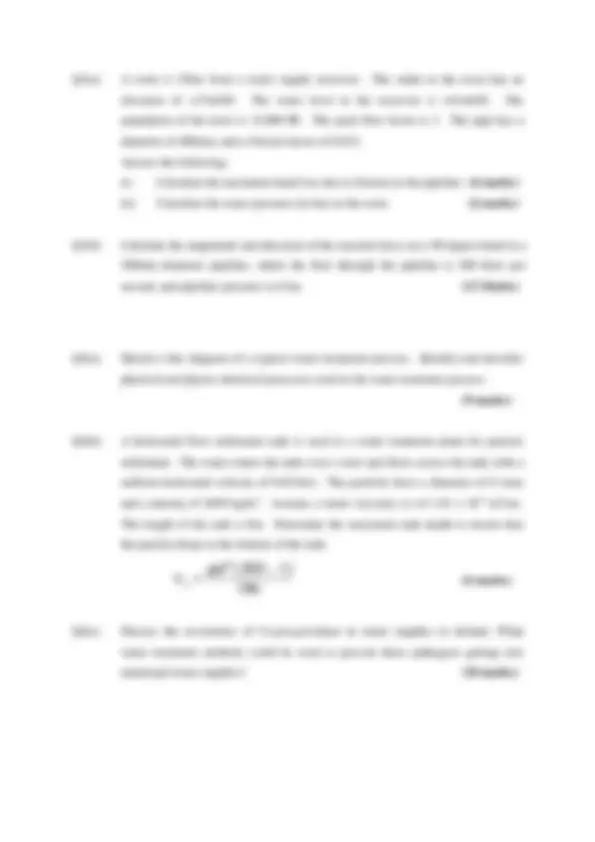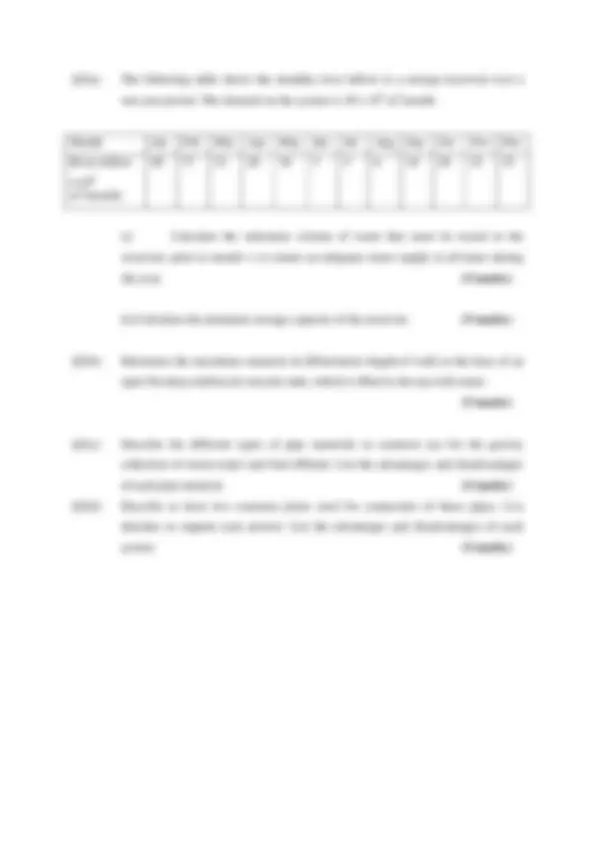




Study with the several resources on Docsity

Earn points by helping other students or get them with a premium plan


Prepare for your exams
Study with the several resources on Docsity

Earn points to download
Earn points by helping other students or get them with a premium plan
Community
Ask the community for help and clear up your study doubts
Discover the best universities in your country according to Docsity users
Free resources
Download our free guides on studying techniques, anxiety management strategies, and thesis advice from Docsity tutors
Main points of this past exam are: Water Framework Directive, Non-Point Source Pollution, Nutrient Management Plan, Water Quality, Sources of Water Pollution, Convergence Point, Dry Weather Flow, Activated Sludge System, Dewatering Processes
Typology: Exams
1 / 4

This page cannot be seen from the preview
Don't miss anything!



CORK INSTITUTE OF TECHNOLOGY INSTITIÚID TEICNEOLAÍOCHTA CHORCAÍ
Semester 2 Examinations 2009/
Module Code: CIVL 6027
School: Civil, Structural and Environmental Engineering
Programme Title: Bachelor of Engineering in Civil Engineering
Programme Code: CCIVL_7_Y
External Examiner(s): Ms. M. Kyne, Mr. J. Murphy
Internal Examiner(s): Mr TL O’Driscoll, Mr P Kennedy
Instructions: Answer four questions
Duration: 2 hours
Sitting: Autumn 2010
Requirements for this examination:
Note to Candidates: Please check the Programme Title and the Module Title to ensure that you have received the correct examination paper. If in doubt please contact an Invigilator.
Q1(a) Explain the following terms in relation to water quality: (i) Water Framework Directive (4 marks) (ii) Non-point source pollution (4 marks) (iii) Nutrient Management Plan (4 marks)
Q1(b) A tributary river has a flow rate of 25 m^3 /sec and a BOD 5 level of 0.7 mg/l. It converges with the main channel, which has a flow rate of 78 m^3 /sec and a BOD 5 level of 0.5 mg/l. Determine the BOD 5 level downstream of the convergence point. (6 marks) Q1(c) One of the main sources of water pollution occurs as a result of agricultural runoff. Explain how this affects water quality, and how it can be prevented. (7 marks)
Q2(a) A conventional activated sludge plant is designed to treat wastewater for a town with a population of 40,000. The activated sludge system is to be preceded by a primary settlement stage, with 30% BOD reduction. Assuming a dry weather flow of 180 litres/pe/day with 250mg BOD/litre, and a maximum allowable BOD of 25 mg/l at the outlet from the works, calculate the following: (i) Total daily flow and BOD load to the treatment plant (3 marks) (ii) Diameter of circular settlement tanks if four parallel tanks are to be built, with an average upward flow velocity of 1.5m/hr (5 marks) (iii) Calculate the total daily BOD removed from the activated sludge plant. (5 marks) Q2(b) Describe how a typical activated sludge system for a wastewater treatment plant works. (6 marks) Q2(c) Describe two typical sludge dewatering processes used to treat municipal wastewater. (6 marks)
Q5(a) The following table shows the monthly river inflow to a storage reservoir over a one year period. The demand on the system is 20 x 10^5 m^3 /month.
Month Jan Feb Mar Apr May Jun Jul Aug Sep Oct Nov Dec River Inflow (x10^5 m^3 /month)
(i) Calculate the minimum volume of water that must be stored in the reservoir, prior to month 1, to ensure an adequate water supply at all times during the year. (5 marks)
(ii) Calculate the minimum storage capacity of the reservoir. (5 marks)
Q5(b) Determine the maximum moment (in KNm/meter length of wall) at the base of an open 9m deep reinforced concrete tank, which is filled to the top with water. (5 marks)
Q5(c) Describe the different types of pipe materials in common use for the gravity collection of storm-water and foul effluent. List the advantages and disadvantages of each pipe material. (5 marks) Q5(d) Describe at least two common joints used for connection of these pipes. Use sketches to support your answer. List the advantages and disadvantages of each system. (5 marks)